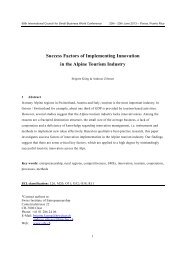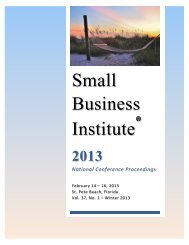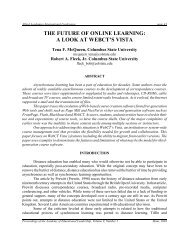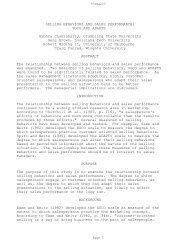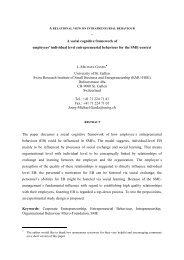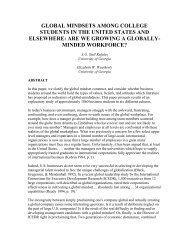The Entrepreneur - Small Business Advancement National Center
The Entrepreneur - Small Business Advancement National Center
The Entrepreneur - Small Business Advancement National Center
Create successful ePaper yourself
Turn your PDF publications into a flip-book with our unique Google optimized e-Paper software.
General Framework for Public Education of<br />
<strong>Entrepreneur</strong>s<br />
by Jan Laubscher 1<br />
Today’s society seems to be marked by increasing poverty and an apparently unequal<br />
allocation of opportunities. – While the first point is undoubtedly a fact, the second one is not<br />
necessarily true. Common problems concerning opportunities are a lack of perception and<br />
the belief in being able to pursue them.<br />
One way to engage these problems is educating people in entrepreneurship.<br />
To be an entrepreneur does not necessarily mean to become a reckless business man. It<br />
means instead to be fulfilled with the fundamental volition to satisfy the needs of others and,<br />
in doing so, to ensure one’s own financial liberty.<br />
<strong>The</strong>refore, entrepreneurs possess the will and ability to innovate given patterns, the<br />
awareness for risk combined with the readiness to bear it, the sense for the future<br />
development of people’s needs, and of course a good pinch of entrepreneurial spirit. Fields of<br />
deployment can be found everywhere within our society.<br />
Introduction<br />
All over the world, leaders and academics are talking about the importance of<br />
entrepreneurship and having entrepreneurs in our society. <strong>The</strong>y state that the economic and<br />
cultural soil has to be prepared for entrepreneurs, that we have to cultivate and foster them.<br />
(Richtermeyer, et al., 2005)<br />
Jan Laubscher holds a degree in business and engineering (Diplom-Wirtschaftsingenieur)<br />
from the University of Karlsruhe (TH), Germany. For his thesis he analyzed the effectiveness<br />
of support programs for entrepreneurship by the federal government of Germany. Besides his<br />
studies he worked for four years at the Interdisciplinary Institute for <strong>Entrepreneur</strong>ship<br />
Karlsruhe. Currently, he is taking part in the Master of <strong>Business</strong>, <strong>Entrepreneur</strong>ship and<br />
Technology (MBET) program at the University of Waterloo, Canada. Please address all<br />
correspondence electronically to Jan.Laubscher@iep.uni-karlsruhe.de.<br />
Page | 1
But:<br />
What is an entrepreneur?<br />
And:<br />
What is so special about her or him?<br />
And even more important:<br />
Why should we spend money to educate and train such individuals?<br />
This paper will provide answers to these questions and illustrate ways to achieve the goal to<br />
foster entrepreneurship.<br />
<strong>The</strong> <strong>Entrepreneur</strong> – Who or What Is That?<br />
Historically, the term entrepreneur goes back to the 16 th century. It is first used in France for<br />
an adventurer that hires mercenaries and offers his services for a wide variety of aims<br />
(Fallgatter, 2002). Later it is also used for men of action that conclude contracts for official<br />
tasks, implement new agricultural techniques, invest their own money in new industries and<br />
also for leaders of military expeditions (Malek, et al., 2004).<br />
Cantillon (1931) is the first one who uses the term to describe a specific sort of economic<br />
participant in 1755. In his understanding of society there are three different categories of<br />
people:<br />
<br />
<br />
<br />
Landowners,<br />
Wage earners, and<br />
<strong>Entrepreneur</strong>s.<br />
As for him entrepreneurs are the ones that induce economic balance by bringing together<br />
demand and offer; it is the ability to handle uncertain income which makes them unique. An<br />
interesting thing about Cantillon’s definition is that he explicitly included beggars and thieves<br />
in categories of people as they live exactly in such an environment of uncertainty.<br />
Following Cantillon many different concepts concerning the meaning of the word<br />
entrepreneur were evolved.<br />
Page | 2
Table 1: Change of Understanding of the Term <strong>Entrepreneur</strong> over Time.<br />
Time Author Definition<br />
Late 18 th century Richard Cantillon Bearer of risk and uncertainty<br />
Anne Robert,<br />
Jaques Turgot<br />
Adam Smith<br />
Investor, whose income is based on<br />
profit, not on interest<br />
Capitalist – self-interest driven user of<br />
capital<br />
19 th century Jean Baptist Say Carrier of information and coordinator<br />
Early 20 th century Joseph Schumpeter Creative destroyer<br />
John M. Keynes<br />
Owner and decision-maker under<br />
uncertainty<br />
Late 20 th century David McClelland Energetic person who takes risks<br />
Peter Drucker<br />
Israel M. Kirzner<br />
Albert Shapero<br />
Seizer of business opportunities<br />
Resourceful opportunist and information<br />
broker<br />
Person who shows initiative, organizes<br />
social and economic contexts and is able<br />
to accept the risk of failure<br />
Although, these concepts evolved in different times and settings, all of them generally can be<br />
categorized in five groups; according to the function respectively role the entrepreneur plays<br />
in the society. Table 2 shows those different entrepreneurial aspects and the most important<br />
and prevailing academic proponents.<br />
Page | 3
Table 2: <strong>The</strong> Five Aspects of an <strong>Entrepreneur</strong> and their Academic Proponents.<br />
Function<br />
Academic Proponents<br />
Innovator Schumpeter (1993), Fallgater (2001), Werner (2004), Aff (2006)<br />
Founder Werner (2004), Aff (2006)<br />
Opportunist von Mises (1940), Kirzner (1973), Freiling (2006)<br />
Risk-bearer Liles (1974), McGrath (1999), Malek (2004), Kollmann (2005),<br />
Jacobson (2006), Bröckling (2007)<br />
Fulfiller of needs von Mises (1940), Werner (2004)<br />
<strong>The</strong> Five Aspects of an <strong>Entrepreneur</strong> – What Makes<br />
Her/Him so Special?<br />
Innovator – Capability and Will to Innovate<br />
In his role as innovator the entrepreneur evokes economic processes of change. He is driven<br />
by the wish to create something new and change existing patterns. For Schumpeter (1993)<br />
this is the most important driver of modern economy: the innovative destruction. Although,<br />
Schumpeter focuses on economic aspects, this also applies to other fields, especially for<br />
social problems. Thus, the entrepreneur makes an invaluable contribution to the progress of<br />
civilization overall by overcoming antiquated structures and pushing new ideas.<br />
Founder – Founder of a Company<br />
<strong>The</strong> economic understanding of founder is based on establishing her or his own economic<br />
base by founding a new organization; and, therefore, having the freedom of will and decision.<br />
Thus, it is closely linked to the risk-bearer concept as the risk of failure with all its<br />
implications always comes along with economic independence. On the other hand, this<br />
independence is what allows the entrepreneur to do what has to be done to fulfil his role as<br />
innovator and opportunist. Unlike employees or so called intrapreneurs – heteronomous<br />
entrepreneurs inside companies – which are incorporated in usually very rigid structures, the<br />
Page | 4
eal entrepreneur disposes of all opportunities he needs to grasp by being responsible only to<br />
her-/himself and her/his conscience (Aff, 2006/07).<br />
Opportunist – Perceptual Capacity for Arbitrage<br />
Economic opportunism means being aware of all opportunities and use each as good as<br />
possible (Torsvik, 2000). For an entrepreneur this awareness is a crucial skill. Kirzner (1973)<br />
even goes one step further and defines this alertness – the ability to make spontaneous<br />
discoveries without purposefully looking for them – as the most unique capability of the<br />
entrepreneur. For her or him the real entrepreneurial act is not seizing opportunities but<br />
finding them.<br />
“<strong>Entrepreneur</strong>ship does not consist of grasping a free ten dollar bill which one has<br />
already discovered to be resting in one’s hand, it consists in realizing that it is in<br />
one’s hand and that is available for the grasping.”<br />
Israel M. Kirzner (1973)<br />
<strong>The</strong>refore, the entrepreneur<br />
<br />
finds not yet used opportunities and systematically unlocks them, or<br />
even generates such opportunities by activating latent demands (Freiling, 2006).<br />
In economic terms, by doing so the entrepreneur balances offer and demand in the market.<br />
Risk-Bearer – Risk Awareness and Readiness to Bear It<br />
“I lack the fear gene. That’s what mad entrepreneurship possible for me.”<br />
Rhonda Kallman (Mansueto Ventures LLC, 2004)<br />
Although, entrepreneurs obviously have to have a higher readiness to assume risk Koch, et al.<br />
(2001), and Jacobson (2006) show that this is not the case. In fact, entrepreneurs seem to<br />
have a medium readiness to bear risk. But as they possess the ability to assess and control risk<br />
better than average, they are able to take risks others judge as to high just because they know<br />
that this is not true. Positively linked to success, this ability seems to be another important<br />
one for these special individuals (Jacobson, 2006). Not for nothing, risk usually goes hand in<br />
hand with opportunity.<br />
Page | 5
In addition, entrepreneurs tend to accept failure far better than the average. McGrath (1999)<br />
calls this the principle of Falling Forward and explains that this not only includes<br />
anticipating and using the negative but also the positive impacts of making failures.<br />
“One reason why failure offers benefits is because it is often easier to pinpoint why<br />
failure has occurred that to explain a success, making failure analysis a powerful<br />
mechanism for resolving uncertainty.”<br />
Sim B. Sitkin (McGrath, 1999)<br />
Fulfiller of Needs – Anticipation Based Will to Satisfy Customer Needs<br />
Without customers any business is foredoomed. It is not the company owners or managers<br />
who make the decision to be successful, but the customers through their purchase behaviour<br />
(Von Mises, 1980). Thus, being a real entrepreneur always means to navigate as close to the<br />
real demand as possible. But this not just means to know what the market was or is about but<br />
more important what it will be about. Anticipating future trends and demands is perhaps the<br />
most important aspect of an entrepreneur as he can be as good as possible in all other aspects;<br />
without customers his business has absolutely no chance to flourish – and survive (Werner,<br />
2004).<br />
<strong>The</strong> <strong>Entrepreneur</strong> in Summary<br />
It is not one or two of these aspects but the combination of all of those in her/his person is<br />
what makes the entrepreneur so special and what makes him different from all other sorts of<br />
business leaders (Pleitner, 2001).<br />
Impact of <strong>Entrepreneur</strong>ship<br />
After knowing what an entrepreneur is, it is important to find out why we, as a society, need<br />
such individuals. History and science document several reasons to do so. Following are the<br />
most important and obvious ones.<br />
Influence of <strong>Entrepreneur</strong>ship on Economic Growth and Public Welfare<br />
In fact, countries with a more positive attitude towards entrepreneurship across their citizens<br />
tend to have higher economic growth rates and lower unemployment rates, both of which<br />
result in increased public welfare. In their research paper for the Organisation for Economic<br />
Co-operation and Development (OECD) Audretsch, et al., (2001) show that this is not just<br />
Page | 6
coincidence but a distinct result of an increasing entrepreneurial activity. Thus, fostering<br />
entrepreneurship education is a long term investment in future economic growth of the whole<br />
society. Figure 1 shows different ways of how these effects can emerge and how they are<br />
interconnected to each other (Carrer, et al., 2003). It also shows some of the initial factors for<br />
entrepreneurship already discussed above and, in anticipation of the following chapter, points<br />
out opportunities to positively influence the willingness to be entrepreneurial in our society.<br />
Figure 1: Framework for Linking <strong>Entrepreneur</strong>ship to Economic Growth (Carrer, et al., 2003).<br />
Level of<br />
Analysis<br />
Conditions for<br />
<strong>Entrepreneur</strong>ship<br />
Crucial Elements of<br />
<strong>Entrepreneur</strong>ship<br />
Impact of<br />
<strong>Entrepreneur</strong>ship<br />
Individual<br />
level<br />
Psychological<br />
endowments<br />
Culture<br />
institutions<br />
Attitudes<br />
Skills<br />
Actions<br />
Self-realization<br />
Personal wealth<br />
Firm<br />
level<br />
<strong>Business</strong> culture<br />
incentives<br />
Start-ups<br />
Entry into new markets<br />
Innovations<br />
Firm performance<br />
Macro<br />
level<br />
Culture<br />
institutions<br />
Variety<br />
Competition<br />
Selection<br />
Competitiveness<br />
Economic growth<br />
Social <strong>Entrepreneur</strong>ship<br />
Profit orientation of businesses seldom results in satisfaction of basic needs in developing<br />
countries. This is because making profit, unfortunately, is often connected to more luxury<br />
goods as to basic needs (Simons, et al., 1987). On the other hand, donation based<br />
organisations often have to deal with managerial and organisational inefficiencies<br />
(Perlmutter, 1995). <strong>The</strong> new entrepreneur combines both – the efficiency of a profit based<br />
venture and the urge to feel useful respectively being recognized and acknowledged for what<br />
one does.<br />
Page | 7
Social entrepreneurship:<br />
Using entrepreneurial spirit and efficiency of the private<br />
industry to solve social problems (Müller, 2009).<br />
<strong>The</strong> best known organisation in this field today certainly is the Grameen Bank, respectively<br />
Grameen Foundation, founded by Dr. Muhammad Yunus 1983. Launching his idea into a<br />
business not only made Dr. Yunus an entrepreneur himself but with the money he has been<br />
lending to his customers thousands and thousands others more. <strong>The</strong> impact of this<br />
revolutionary concept not just consisted of financial independence of former poor people but<br />
also of a movement towards collaboration and mutual aid all over Bangladesh – and after<br />
being granted the Nobel Peace Prize in 2006 all over the world (Martin, et al., 2007).<br />
Another very successful example is the SEKEM Initiative founded by Dr. Ibrahim Abouleish<br />
1977 in Egypt with its “vision of sustainable human development” (Sekem Group, 2006).<br />
Social entrepreneurship, as a result of enabling and encouraging people to implement their<br />
own innovative solutions for daily problems, is a major pillar of recent improvement of living<br />
conditions in developing countries (Seelos, et al., 2004, and Dees, 1998).<br />
“Furthermore, we might as well take advantage of this explosion of social<br />
entrepreneurship. <strong>The</strong>se are some of the smartest and most creative people in the<br />
country. Even if we don’t know how to reduce poverty, it’s probably worth investing<br />
in these people and letting them figure it out. – <strong>The</strong>y won’t stop bugging us until we<br />
do.”<br />
(Brooks, 2008)<br />
Educating <strong>Entrepreneur</strong>s<br />
So, we know now what entrepreneurs are and that this category of people is so beneficial for<br />
society. But how do we encourage people to act entrepreneurial, how do we train and educate<br />
them?<br />
This chapter will briefly explain a five step approach to make sure that all five aspects<br />
indentified in the first part come together in one person.<br />
1. Sensitising and Encouragement<br />
<strong>The</strong> very first step consists of making people aware that there are such opportunities to be<br />
independent and economic autonomous. This cannot happen too early – as children are<br />
Page | 8
generally open-minded and receptive, workshops or even entrepreneurship classes would be<br />
very efficient. However, not only children are eligible for such awareness trainings. Anyway,<br />
the goal of such courses must not be pushing participants into something they do not want but<br />
making them aware of opportunities. Furthermore, such courses should show that developing<br />
one’s own initiative is always helpful regardless what the future will be.<br />
2. Assistance during Idea Generation Phase<br />
Giving people the knowledge how to access and use their creative potential will also enable<br />
them to generate new ideas. <strong>The</strong>re are many different techniques to do so, for example<br />
brainstorming, brainwriting, and synectics (Couch, 1993). In addition, it is important to show<br />
that even ideas that are regarded as crazy at the beginning of the day can be a solution at the<br />
end of it. Far too many people tend to judge and refuse such an idea right away without<br />
giving the thought-process a real chance to evolve. This does not mean that every thought<br />
should be executed blindly, but that it is important to be open in mind for unusual solutions.<br />
3. Imparting Knowledge of Marketing Tools and Comprehension of<br />
<strong>Entrepreneur</strong>ial Intuition<br />
After having developed a scope of ideas one should be able to identify the needs of the<br />
people he wants to target with his business. A good understanding and feeling for the specific<br />
market segment is inevitable for such an attempt. <strong>The</strong>refore, trainings about the application of<br />
different marketing tools and even more important about proper interpreting the results<br />
should be given.<br />
4. Training of Ability to Identify and Assess Risk<br />
Risk in business can never be avoided completely but increasing the understanding of risk<br />
makes it less intimidating. Having said this, it is inevitable to show prospective entrepreneurs<br />
typical risk patterns in business and ways to recognize them. This will improve their courage<br />
to engage risk in a proactive way what again results in more control over the situation –<br />
entrepreneurial risk management (McGrath, 1999). In addition, it is important to show people<br />
that failure is an often required learning method to be able to be successful and, therefore,<br />
definitely not bad in general (Ofman, 2009).<br />
5. Qualifying for <strong>Business</strong><br />
<strong>The</strong> phase to build the basic business tools, for example fundamental accounting, business<br />
management, and how to write a realistic business plan and execute it, is the last topic which<br />
Page | 9
has to be covered. <strong>The</strong>re are many different approaches and offers on the market covering<br />
this. However, it is important to choose a practical and tailored method with appropriate case<br />
studies. Although, one would not think so in the first moment, these skills are also important<br />
for social entrepreneurs – perhaps even more than to others, as they usually act in a very<br />
small financial scope. Furthermore, failure in their case often has a serious impact on their<br />
environment – economically, socially, and ecologically.<br />
Conclusions<br />
<strong>The</strong> entrepreneur – who or what is that? An innovator who is able to change existing<br />
patterns and solve social problems?<br />
<br />
<br />
<br />
<br />
A founder who creates opportunities?<br />
An opportunist who understands and forms<br />
the market?<br />
A risk-bearer with a distinctive economic<br />
calculus?<br />
A fulfiller of needs who is driven by the will<br />
to satisfy current and future needs of people?<br />
<strong>The</strong> entrepreneur is not just part of one of these categories – he combines all these<br />
characteristics in his own person.<br />
Education and training entrepreneurs is not like teaching mathematics or history. <strong>The</strong> process<br />
is more based on making aware of opportunities, strengthening self-confidence, and setting<br />
the stage for people to develop and flourish their abilities. Thus, entrepreneurship education<br />
programs should be structured around following framework:<br />
1. Sensitising and encouragement to create the necessary awareness.<br />
2. Assistance during idea generation phase to help developing the basic business idea.<br />
3. Imparting knowledge of marketing tools and comprehension of entrepreneurial<br />
intuition to enable the understanding of potential customers, their needs, and the<br />
market segment in general.<br />
Page | 10
4. Training of ability to identify and assess risk to ensure proper risk management and<br />
foster the readiness to bear risks.<br />
5. Qualifying for business to provide basic business tools and support developing<br />
necessary skills.<br />
<strong>The</strong> positive influence of entrepreneurs on economy and society has been known since the<br />
18 th century and is still valid. Today, the trend to social entrepreneurship has an<br />
unprecedented chance to sustainably change the shape of our world. <strong>The</strong>refore, fostering<br />
entrepreneurship education and giving people the required opportunities to unfold their<br />
entrepreneurial will and ability are not just investments in individuals but in the welfare of<br />
the whole society.<br />
References<br />
Aff, Josef. (2006/07). „<strong>Entrepreneur</strong>ship-Erziehung,“ Wissenplus, Heft1 | 2006/07, pp. I-VIII.<br />
Audretsch, D. B. and R. Thurik. (2001). “Linking <strong>Entrepreneur</strong>ship to Growth,” OECD<br />
Science, Technology and Industry Working Papers, 2001/2. OECD Publishing.<br />
. Accessed on January 30, 2009.<br />
Boeree, C. George. (2006). Abraham Maslov. . Accesed on February 2, 2009.<br />
Bröckling, Ulrich. (2007). Das unternehmerische Selbst. Soziologie einer<br />
Subjektivierungsform. Frankfurt am Main: Suhrkamp.<br />
Brooks, David. (2008). “Thoroughly Modern Do-Gooders,” New York Times, March 21,<br />
2008. . Accessed on<br />
January 25, 2009.<br />
Cantillon, Richard. (1931). Abhandlung über die Natur des Handels im allgemeinen (nach<br />
der französischen Ausgabe von 1755). Jena: Fischer.<br />
Carree, M. A. and Thurik A. R. (2003). “<strong>The</strong> Impact of <strong>Entrepreneur</strong>ship on Economic<br />
Growth,” International Handbook of <strong>Entrepreneur</strong>ship Research. New York: Springer.<br />
Casson, Mark. (1982). <strong>The</strong> <strong>Entrepreneur</strong>. An Economic <strong>The</strong>ory. Oxford: Robertson.<br />
Page | 11
Couch, Richard. (1993). “Synectics and Imagery: Developing Creative Thinking Through<br />
Images,” Art, Science & Visual Literacy: Selected Readings from the Annual Conference of<br />
the International Visual Literacy Association (24th, Pittsburgh, PA. September 30 - October<br />
4, 1992).<br />
Dees, J. Gregory. (1998). <strong>The</strong> Meaning of “Social <strong>Entrepreneur</strong>ship”.<br />
.<br />
Accessed on January 25, 2009.<br />
Fallgatter, Michael J. (2002). <strong>The</strong>orie des <strong>Entrepreneur</strong>ship. Perspektiven zur Erforschung<br />
der Entstehung und Entwicklung junger Unternehmen. Wiesbaden : Deutscher Universitäts-<br />
Verlag.<br />
Freiling, Jörg. (2006). <strong>Entrepreneur</strong>ship. <strong>The</strong>oretische Grundlagen und unternehmerische<br />
Praxis. München: Verlag Franz Vahlen.<br />
Mansueto Ventures LLC (2004). What quality or skill is the most critical to success as an<br />
entrepreneur? . Accessed on July<br />
02, 2008.<br />
Martin, Roger L. and Osberg, Sally. (2007). “Social <strong>Entrepreneur</strong>ship: <strong>The</strong> Case for<br />
Definition,” Stanford Social Innovation Review. Stanford: Leland Stanford Jr. University.<br />
.<br />
Accessed on January 28, 2009.<br />
Jacobson, Liv Kirsten. (2006). Erfolgsfaktoren bei der Unternehmensgründung.<br />
<strong>Entrepreneur</strong>ship in <strong>The</strong>orie und Praxis. Wiesbaden: Deutscher Universitäts-Verlag.<br />
Kirzner, Israel M. (1973). Competition and <strong>Entrepreneur</strong>ship. Chicago: <strong>The</strong> University of<br />
Chicago.<br />
Knight, Frank H. (2005). Risk, Uncertainty and Profit. New York: Cosimo.<br />
Koch, Lambert T. and Zacharias, Christoph. (2001). Gründungsmanagement mit Aufgabe und<br />
Lösungen. München: Oldenbourg Wissenschaftsverlag.<br />
Kollmann, Tobias [Ed.]. (2005). GABLER KOMPAKT-LEXIKON. Unternehmensgründung.<br />
Wiesbaden: Betriebswirtschaftlicher Verlag Dr. Th. Gabler.<br />
Page | 12
Liles, Patrick R. (1974). New business ventures and the entrepreneur. Homewood, Illinois:<br />
Irwin.<br />
Low, Murray B. and MacMillan, Ian C. (1988). “<strong>Entrepreneur</strong>ship: Past Research and Future<br />
Challenges,” Journal of Management, 14(2), pp. 139-161.<br />
Malek, Miroslaw and Ibach, Peter K. (2004). <strong>Entrepreneur</strong>ship. Prinzipien, Ideen und<br />
Geschäftsmodelle zur Unternehmensgründung im Informationszeitalter. Heidelberg:<br />
dpunkt.verlag.<br />
McGrath, Rita G. (1999). “Falling Forward: Real Options Reasoning and <strong>Entrepreneur</strong>ial<br />
Failure,” Academy of Management, Vol. 24, No. 1, pp. 13-30.<br />
Müller, Susan. (2009). „Soziale Marktwirtschaft,“ brand eins, 01/2009.<br />
. Accessed on February 02, 2009.<br />
Ofman, Paul. (2009). “<strong>Entrepreneur</strong>s and Failure – Why you can benefit from big mistakes,”<br />
<strong>Business</strong>Week, <strong>Small</strong>Biz Video. . Accessed on January 30, 2009.<br />
Perlmutter, Felice D. and Cnaan, Ram A. (1995). “<strong>Entrepreneur</strong>ship in the Public Sector: <strong>The</strong><br />
Horns of a Dilemma,” Public Administration Review, Vol. 55, No. 1, pp. 29-36.<br />
Pleitner, Hans J. (2001). „<strong>Entrepreneur</strong>ship - Mode oder Motor?,“ Zeitschrift für<br />
Betriebswissenschaft, Vol. 10, pp. 1145-1159.<br />
Pomerantz, Mark. (2003). „<strong>The</strong> <strong>Business</strong> of Social <strong>Entrepreneur</strong>ship in A ‚Down Economy‘,”<br />
In <strong>Business</strong>, March/April 2003, p. 25. . Accessed on April 20, 2009.<br />
Ramge, Thomas. (2009). „Klein, aber fein,“ brand eins, 01/2009.<br />
. Accessed on February 02, 2009.<br />
Richtermeyer, Gwen and Venters, Cassy. (2005). „Why is <strong>Entrepreneur</strong>ship an Important<br />
Economic Development Strategy?“ presented at the <strong>National</strong> Association of Community<br />
Development Extension Professionals Conference, Las Vegas, NV, February.<br />
Page | 13
.<br />
Accessed on April 25, 2009.<br />
Schumpeter, Joseph A. (1993). <strong>The</strong>orie der wirtschaftlichen Entwicklung - Eine<br />
Untersuchung über Unternehmergewinn, Kapital, Kredit, Zins und den Konjunkturzyklus.<br />
Berlin: Duncker und Humblot.<br />
Schumpeter Joseph A. (2002). „<strong>The</strong>orie der wirtschaftlichen Entwicklung,“ In: <strong>The</strong> American<br />
journal of economics and sociology: publ. quarterly in the interest of constructive synthesis<br />
in the social sciences under grants from the Francis Nelson Fund and the Robert<br />
Schalkenbach Foundation, Vol. 61, No. 2, pp. 405-437.<br />
Seelos, Christian and Mair, Johanna. (2004). <strong>Entrepreneur</strong>s in service of the poor: Models for<br />
business contributions to sustainable development. Barcelona: IESE <strong>Business</strong> School.<br />
.<br />
Accessed on January 25, 2009.<br />
Sekem Group. (2006). Welcome to Sekem. .<br />
Accessed on February 2, 2009.<br />
Simons, Janet A.; Irwin Donald B. and Drinnien, Beverly A. (1987). Psychology – <strong>The</strong><br />
Search for Understanding. New York: West Publishing Company.<br />
Sitkin, Sim B. (1992). “Learning through failure: <strong>The</strong> strategy of small losses,” Research in<br />
organizational behaviour, Vol. 14, pp. 231-266.<br />
Temple, Nick. (2009). Top 10 social entrepreneurship trends for 2009.<br />
.<br />
Accessed on January 29, 2009.<br />
Torsvik, Gaude. (2000). “Social capital and economic development,” Rationality and Society,<br />
Vol. 12, No. 4, pp. 451-476.<br />
Von Mises, Ludwig. (1980). <strong>National</strong>ökonomie. <strong>The</strong>orie des Handelns und Wirtschaftens.<br />
München: Philosophia Verlag.<br />
Werner, Götz W. (2004). Wirtschaft – das Füreinander-Leisten. Karlsruhe:<br />
Universitätsverlag Karlsruhe.<br />
Page | 14



